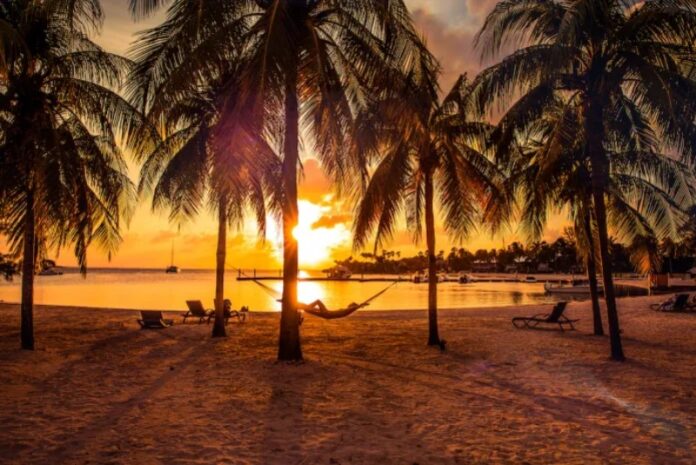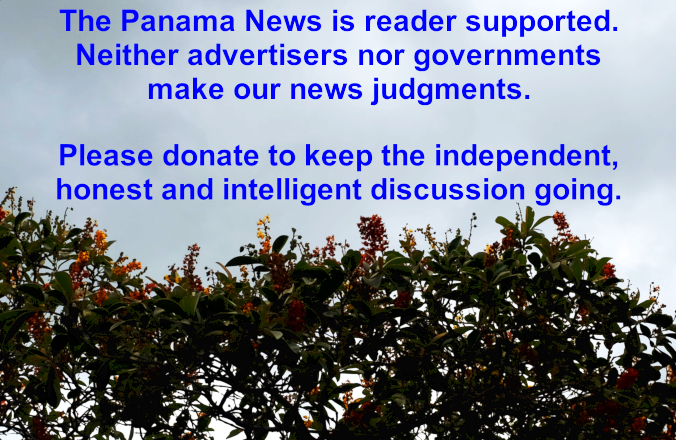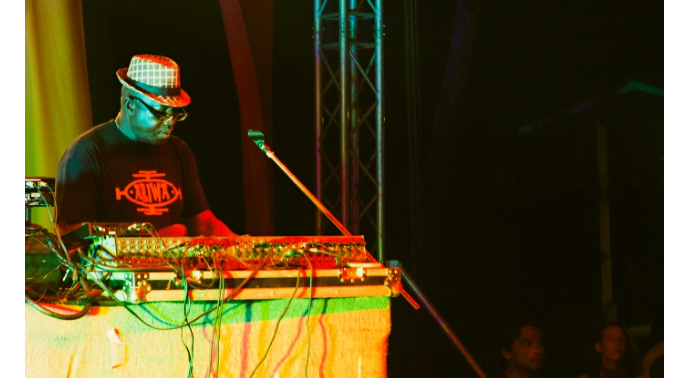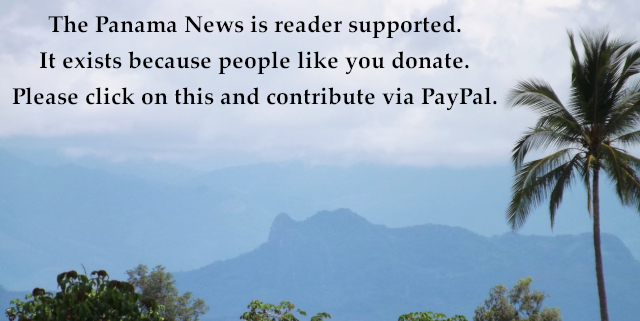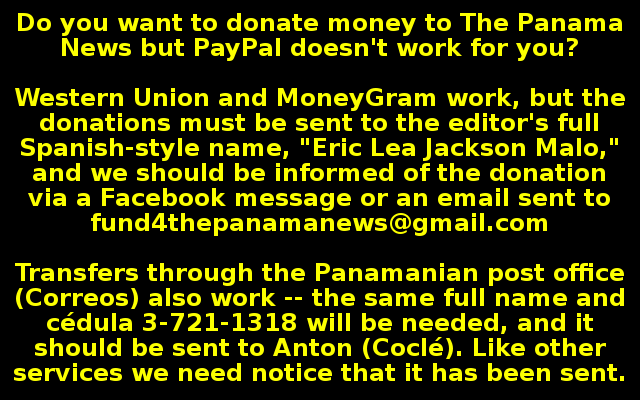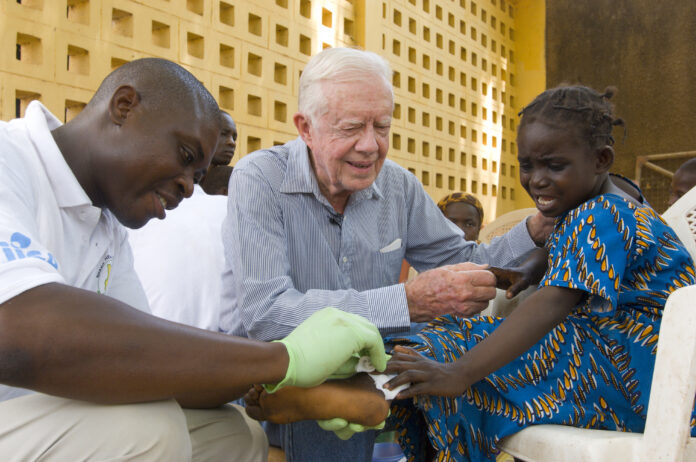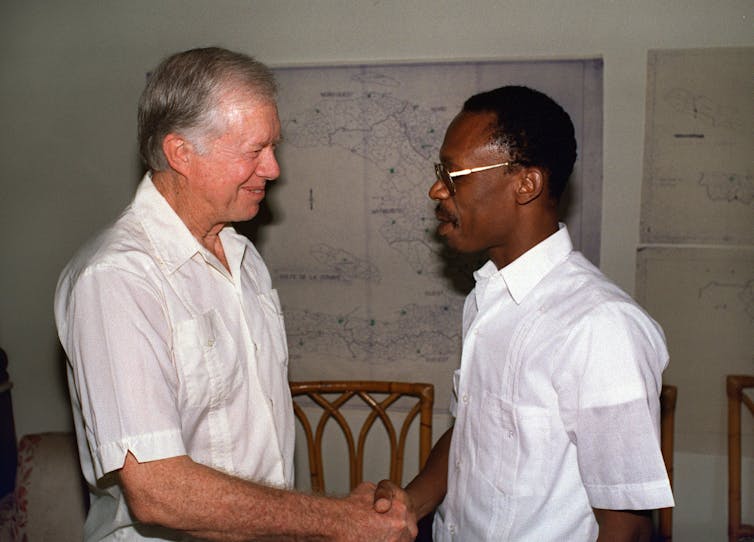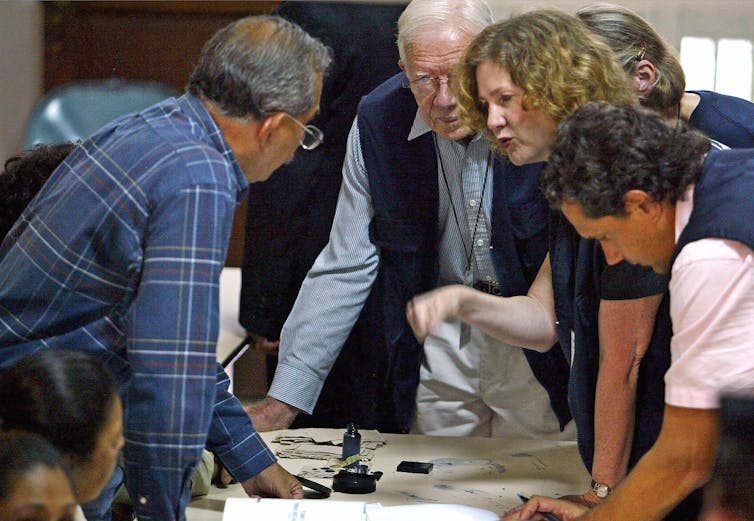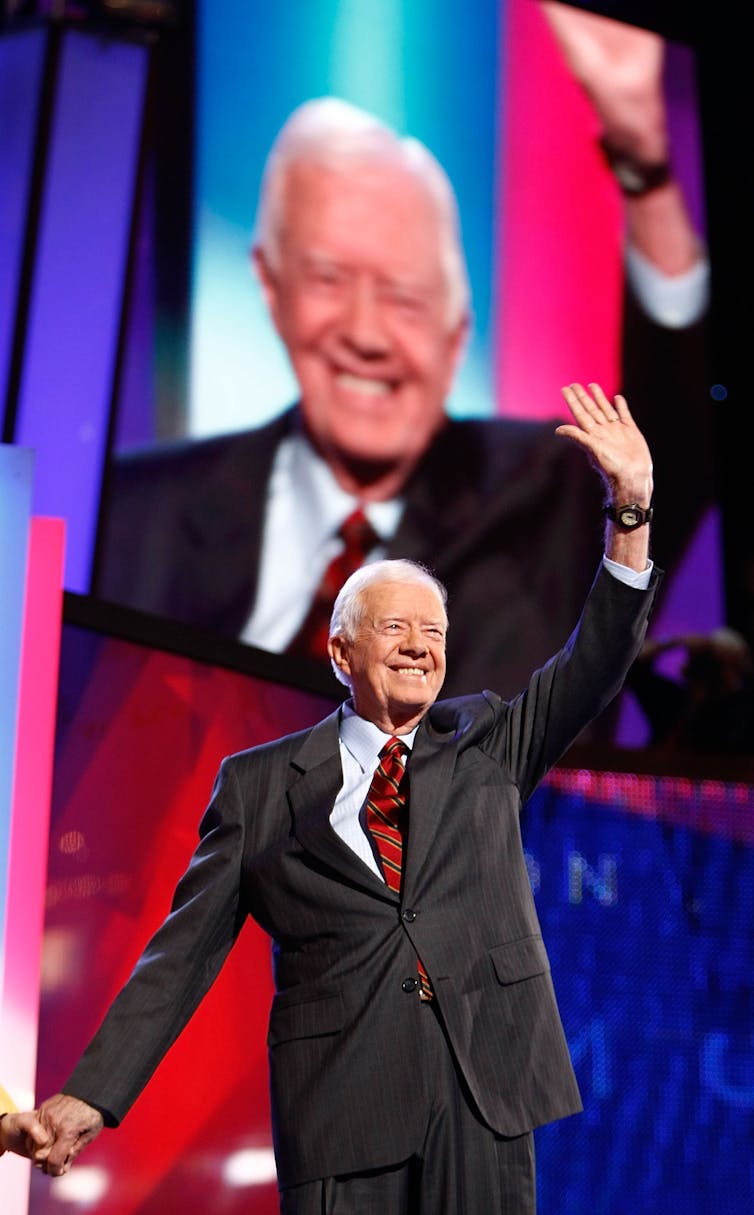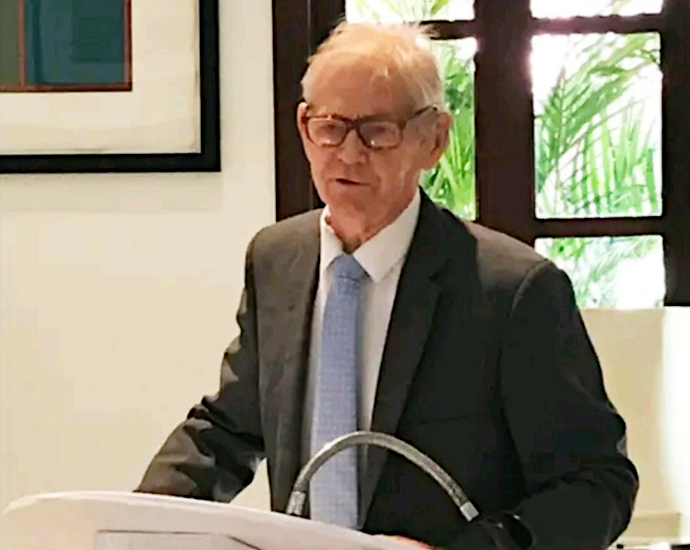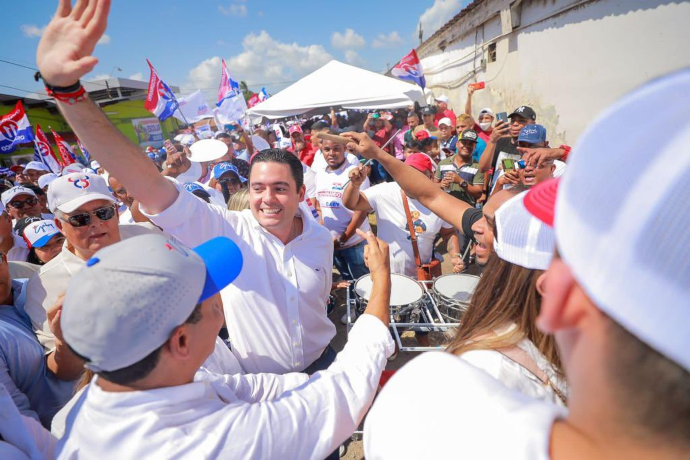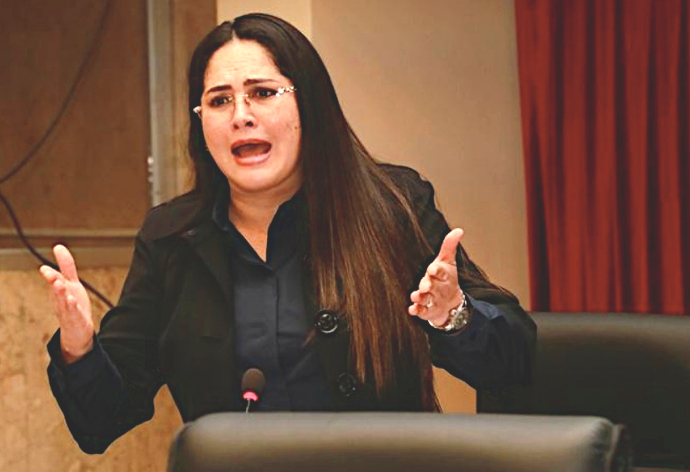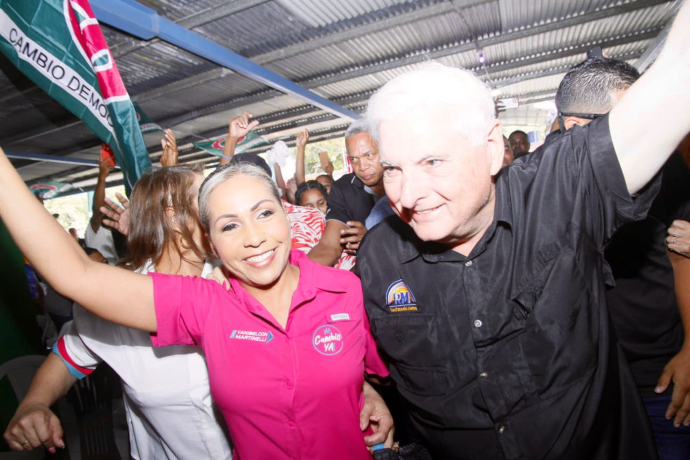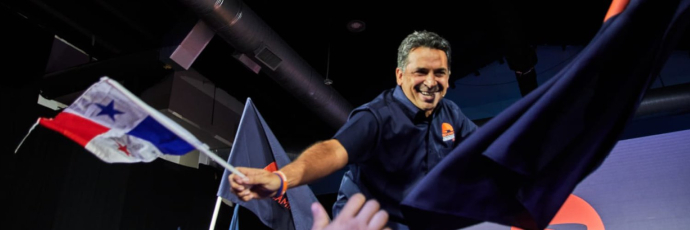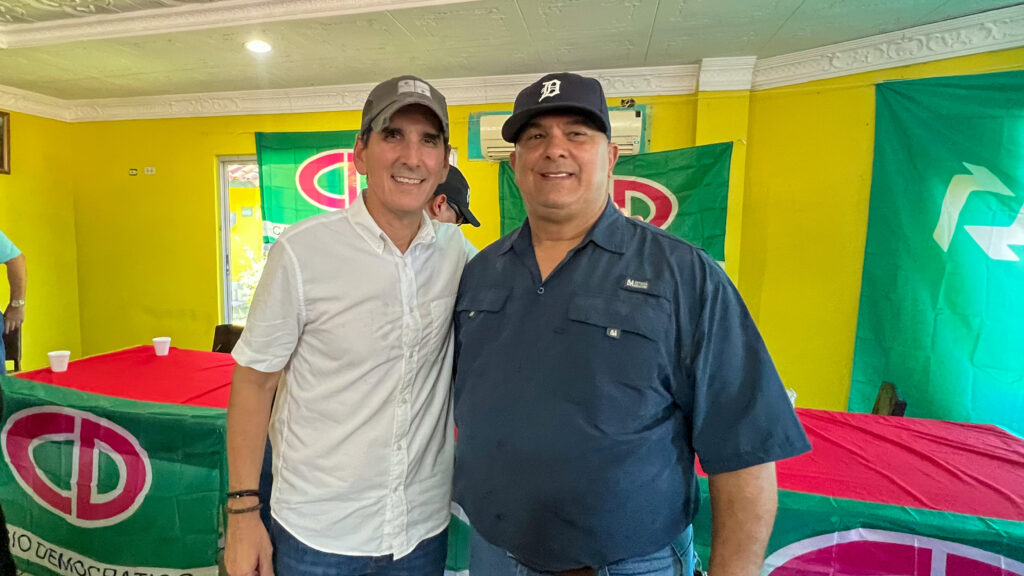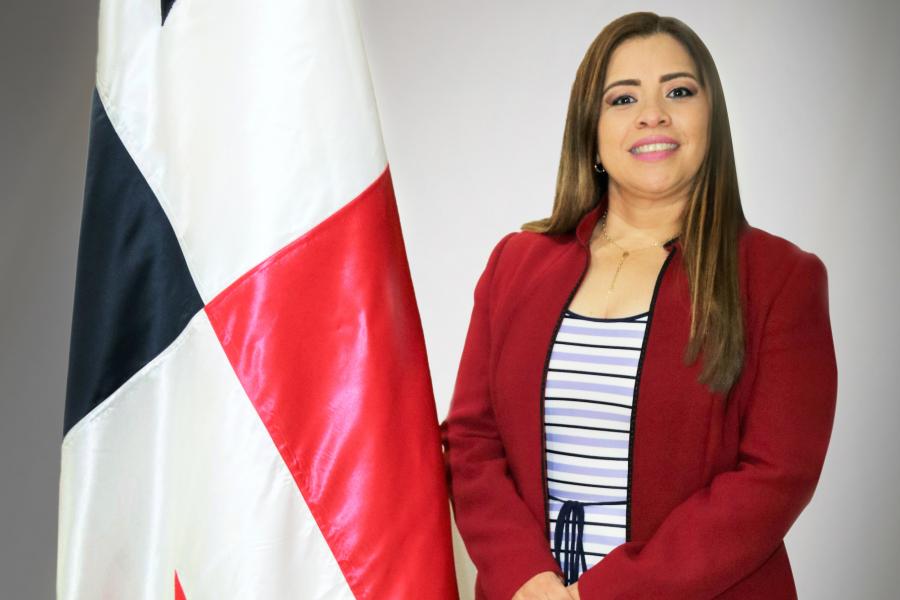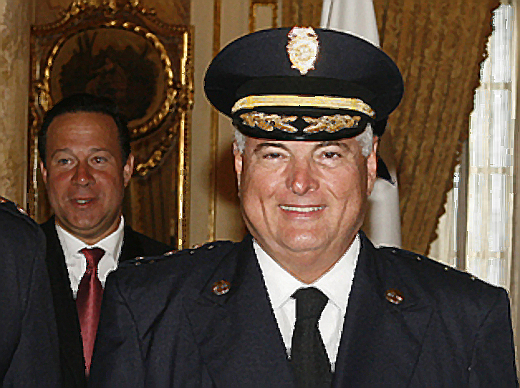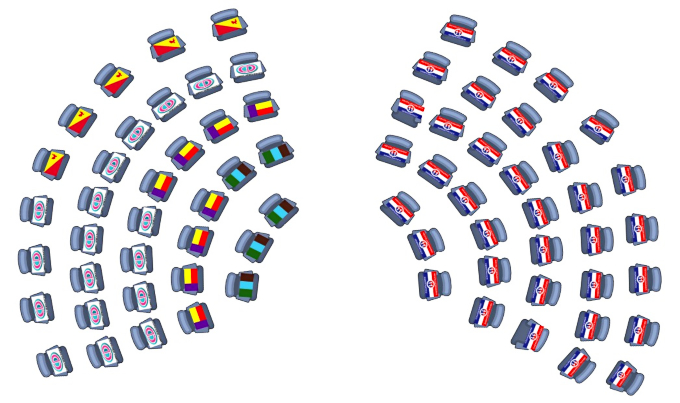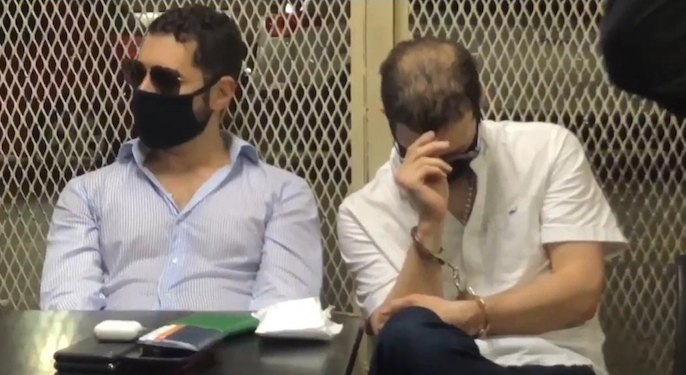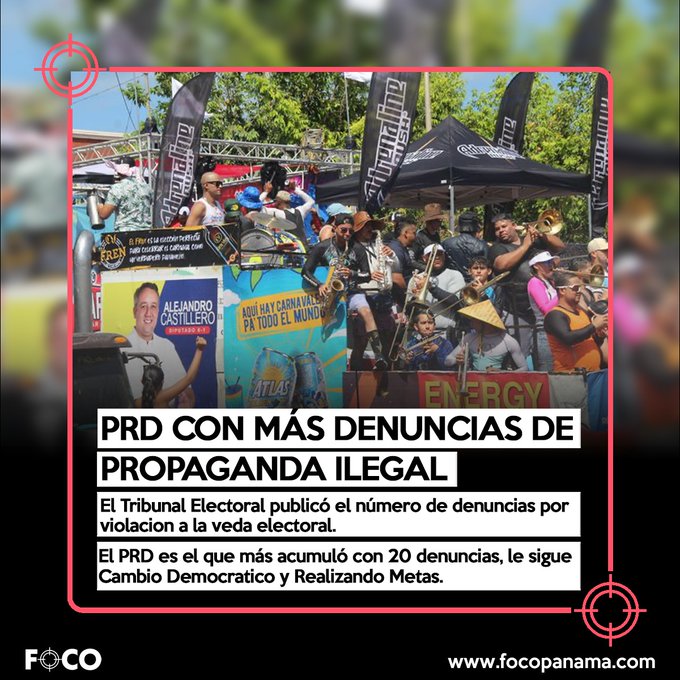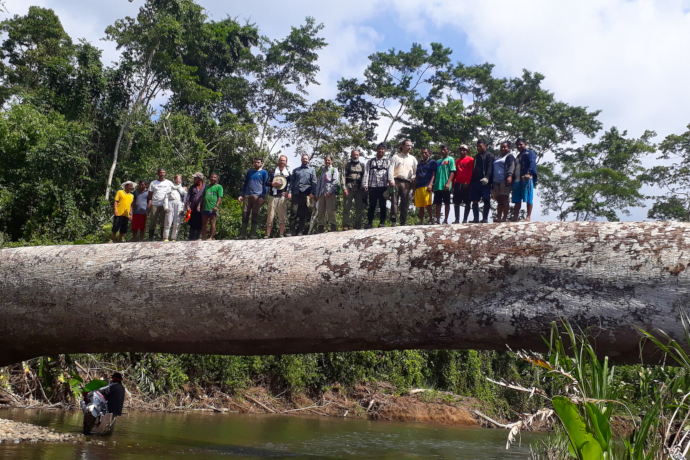El Centro de Investigaciones de la Facultad de Humanidades (CIFHU) de la Universidad de Panamá lamenta el fallecimiento del insigne arqueólogo y antropólogo Richard Cooke. El equipo de investigadores del CIFHU hace llegar sus condolencias a su hija, Juana Cooke Camargo, a la profesora Marcela Camargo, ex directora del CIFHU, y a nuestro colega Florencio Díaz.
Debajo vea a un artículo por Diana R. Carvajal, de la Universidad Externado de Colombia, sobre la prolífica obra que Cooke lega a la sociedad panameña. Artículo titulado “Richard Cooke: arqueología y divulgación en Panamá”.
Richard Cooke: arqueología y divulgación en Panamá
por Diana R. Carvajal — Universidad Externado de Colombia
Resumen: La divulgación en arqueología en Panamá se ha realizado a través de diferentes medios; como periódicos, revistas, televisión, internet, museos, yacimientos arqueológicos, centros de interpretación, entre otros, que han estado fuertemente permeados por discursos ideológicos propios del contexto político y social. El Dr. Cooke ha actuado como promotor y divulgador de la arqueología panameña desde 1972. Sus iniciativas vinculan temáticas arqueológicas como el poblamiento temprano y la dispersión de grupos humanos en el istmo, el surgimiento de la desigualdad social, la economía de subsistencia prehispánica con temas contemporáneos y que involucran la arqueología con las ciencias sociales y biológicas; como la explotación de ecosistemas marinos y terrestres, el impacto de los grupos humanos sobre dichos ecosistemas, la apropiación del patrimonio arqueológico panameño y la continuidad cultural demostrada por la genética molecular. Es el propósito de este artículo, por lo tanto, hacer un recorrido histórico no exhaustivo por las experiencias divulgativas del Dr. Cooke, no solo en el ámbito académico, sino, sobre todo, para los no arqueólogos. De igual forma, es una manera de reconocer la trayectoria del Dr. Cooke y resaltar su labor dentro de la arqueología pública. Las experiencias divulgativas del Dr. Cooke permitirán hacer una reflexión sobre las prácticas actuales de divulgación de la arqueología en Panamá y por extensión en Latinoamérica.
Introducción1
La divulgación, no solo entre académicos, sino hacia el público en general, ha sido un importante trabajo en arqueología que se realiza a través de diferentes medios como periódicos, revistas, televisión, internet, museos, yacimientos, entre otros. Dichas actividades, aunque interpretan y hacen accesible el conocimiento, han estado fuertemente permeadas por discursos ideológicos propios del contexto político y social.
La difusión de la arqueología y la interacción con las comunidades no son fenómenos nuevos en el mundo o en Latinoamérica (López, 2001; López, Pradilla y Reyes, 1988; López y Reyes, 1994). Esta propagación de los datos arqueológicos se incluyó dentro de la denominada arqueología pública, término utilizado por Charles McGimsey III, en 1972, en su libro Public Archeology. En este libro, el arqueólogo se centra en cuestiones que son aún parte de los debates de la comunidad académica; como la participación de las comunidades locales, la interacción de las comunidades indígenas con el patrimonio arqueológico, la socialización de los trabajos y las interpretaciones del pasado durante los proyectos de arqueología preventiva o de rescate (Merriman, 2004).
Posteriormente, arqueólogos anglosajones incluyeron otras preocupaciones que iban más allá de la mera difusión y participación públicas. Dichas preocupaciones aún están latentes, particularmente en Latinoamérica, como el tráfico ilícito de antigüedades, el impacto del conflicto armado sobre el patrimonio arqueológico, el uso político de la arqueología, su impacto económico, los derechos indígenas o la imagen que se proyecta a la sociedad del pasado (Funari, 2004). Como se define a continuación, se entiende la arqueología pública, según Almansa (2011, p. 90), como:
Si la arqueología trata de crear un conocimiento novedoso desde el estudio de los restos materiales de sociedades pasadas, la arqueología pública estudia todas las relaciones entre dicha arqueología y la sociedad contemporánea con el ánimo de mejorar la coexistencia entre ambos y lograr un entendimiento generalizado del valor y uso de la arqueología.
A principios del siglo XXI, la arqueología pública se ha desarrollado como una nueva especialización de la arqueología gracias al aporte seminal de Peter Ucko en Inglaterra; y se ha avanzado en campos de acción como la imagen pública de la arqueología en los medios de comunicación, la participación directa de la comunidad en el trabajo arqueológico, entre otros (Moschenka, 2009; Shennan, 2007).
La arqueología, en general, aporta información de los modos de vida de las sociedades del pasado, cuya pertinencia en el presente tiene que ver con la conformación de identidades y procesos de cambio, y el compromiso de la población con el patrimonio arqueológico para su protección y divulgación. Al mismo tiempo, promueve la creación de políticas culturales y el desarrollo sostenible de las comunidades mediante el turismo (Giedelman, 2010; Groot, 2006, 2014).
El doctor Richard Cooke ha contribuido no solo a la arqueología de Panamá; sus investigaciones han aportado a la comprensión de las adaptaciones y economías de las sociedades precolombinas de las tierras bajas tropicales de la baja Centroamérica.
Las diferentes facetas de su trabajo académico, desde que llegó a Panamá en 1969, comprenden la arqueología, la zooarqueología y la etnohistoria (Anexo 1). Muchos de sus aportes son mencionados en este volumen, sin embargo, en este artículo me propongo resaltar la labor del Dr. Cooke dentro de la arqueología pública, de la que fui testigo como su estudiante en las excavaciones en Cerro Juan Díaz y luego a nivel profesional en los trabajos en Cueva de los Vampiros, la Región Occidental de la Cuenca del Canal y en el archipiélago de las Perlas (Figura 1).
Desde 1972, el Dr. Cooke (Anexo 1) mostró una preocupación por llevar su conocimiento especializado a un sector más amplio de la población y mejorar así el mundo que lo rodeaba. Sus iniciativas vinculan temáticas como el poblamiento temprano y la dispersión de grupos humanos en el istmo, la paleoecología, el surgimiento de la desigualdad social, la economía de subsistencia. Su visión del contexto político-social de Panamá y del mundo le han permitido relacionar las problemáticas locales de sus investigaciones con temáticas contemporáneas a una escala temporal y regional mayor, como la explotación de ecosistemas marinos y terrestres, el impacto de los grupos humanos sobre los ecosistemas, la apropiación del patrimonio arqueológico y la continuidad cultural de los grupos indígenas (Cooke y Sánchez, 2004a).
El propósito de este escrito es hacer un recorrido histórico no exhaustivo de las actividades divulgativas del Dr. Cooke, no solo en el ámbito académico, sino sobre todo en la transmisión de ese conocimiento a los no arqueólogos. Estas experiencias permitirán hacer una reflexión sobre las prácticas actuales de divulgación de la arqueología, tanto en Panamá como, en general, en Latinoamérica.
Un recorrido histórico de las actividades divulgativas del arqueólogo Richard Cooke
En una época anterior a los años sesenta, la investigación arqueológica en Panamá se caracterizaba por estudios descriptivos; principalmente las excavaciones de contextos funerarios y la total ausencia de estudios interpretativos en torno a los modos de vida de las poblaciones que habitaron el istmo. La preparación de los investigadores era muy limitada, tanto que la divulgación de conocimiento sobre el pasado precolombino se hacía a partir de fuentes bibliográficas o cátedras de antropología en las escuelas secundarias que negaban la influencia de las poblaciones indígenas sobre la formación del moderno estado panameño y su continuidad dentro de la historia de la nación.
El estudio del pasado en Panamá estaba influenciado por dichos prejuicios coloniales y por una asociación de huaqueros (Sociedad de Arqueología Panameña, SAP) y posteriores investigadores que realizaban trabajos de “arqueología” en yacimientos arqueológicos como Sitio Conte. Las prácticas de la época consideraban lícito que los artefactos eran un tesoro encontrado en las excavaciones y que, por lo tanto, era posible reclamarlo como parte de pago en los contratos celebrados con el gobierno panameño (Haller, 2010; Porras, 2002; Rovira, 2013).
Al momento de llegar el Dr. Cooke a Panamá, a finales de los años sesenta, iniciaba su investigación doctoral. El clima intelectual panameño de la época se caracterizaba por la consolidación institucional y académica de la antropología y arqueología. Las investigaciones y actividades divulgativas de los años sesenta y setenta están fuertemente influenciadas por jóvenes científicos panameños como Reina Torres de Arauz, entre otros; quienes desde la Universidad de Panamá impulsaron el Centro de Investigaciones Antropológicas, la Dirección de Patrimonio Histórico, la creación de las revistas de Patrimonio Histórico y Hombre y Cultura, la apertura de innumerables museos regionales, que demostraban el interés por el estudio del pasado panameño y su divulgación (Constela, 1993; Cooke y Sánchez, 2004a; De Gracia y Mendizábal, 2014; Mendizábal, s.f; Sánchez, 2002).
En esos años, el Dr. Cooke trabajó como profesor de antropología en la Universidad de Panamá; Florida State University, y en la Universidad Santa María la Antigua; y colaboró en los estudios arqueológicos del Museo Americano de Historia Natural como asistente del arqueólogo Junius Bird (Figura 2). Asimismo, laboró bajo contrato para la Unesco y para Patrimonio Histórico en proyectos de salvamento arqueológico en Fortuna, Chiriquí (Cooke y Sánchez, 2004a; Sanjur, 2012).
En dichas posiciones, centró las actividades de divulgación en ámbitos académicos al publicar documentos como “El Rescate Arqueológico en Panamá: Historia, Análisis y Recomendaciones”, donde hace una síntesis de los trabajos arqueológicos en Panamá hasta la fecha y hace algunas recomendaciones acerca de la preservación y divulgación del patrimonio histórico y cultural (Cooke, 1984; Anexo 1).
A finales de los años ochenta, Cooke formó parte del equipo de trabajo del Museo Reina Torres de Arauz, actualizando los guiones y las exhibiciones en las que se aspiraba; en palabras de Marcela Camargo, (2014) a mostrar al visitante cuándo y cómo había surgido el istmo, la presencia de sus primeros pobladores, el desarrollo de esas sociedades y lo sucedido posteriormente con la Conquista y dominio español.
Estas actividades coinciden con el gobierno-dictadura de Omar Torrijos, quien, dentro de sus planes de gobierno liberal y populista, incluía el aumento de la infraestructura, la oferta de educación pública, y dentro de las políticas culturales: la exaltación de la nacionalidad e identidad panameña. Según Camargo (citado por Sánchez [2008]), dichas ideas liberales entorno a lo nacional estaban fuertemente influenciadas por los conceptos de modernidad y civilización de las instituciones europeas y norteamericanas. Esta política de estado, sin duda, impulsó las investigaciones arqueológicas y su difusión (Rovira, 2013; Sánchez, 2002). Solo, hasta estos años, el concepto de patrimonio hace parte del léxico del estado panameño. A raíz de esto, surgieron leyes para reglamentar conjuntos monumentales como Panamá Viejo, Portobelo y Casco Viejo, y se impulsaron actividades turísticas a través del IPAT -Autoridad de Turismo de Panamá (Pizzurno, 2007).
Durante los años ochenta, se destacó el Proyecto Santa María, el cual concentra sus actividades investigativas en torno al poblamiento temprano, la ecología cultural, la arqueozoología con el uso de recursos animales por parte de poblaciones precolombinas. Es en esta década cuando entra el Dr. Cooke a formar parte del staff del Instituto Smithsonian de Investigaciones Tropicales, donde continúa hasta la fecha. El arqueólogo aglutina sus actividades divulgativas en la presentación de artículos y capítulos en importantes revistas científicas, así como la tutoría de estudiantes becarios, la asistencia a voluntarios y la divulgación en reportajes periodísticos para el público en general (Sanjur, 2012; Anexo 1).
Esta década se caracteriza por la crisis político-institucional generada por los comicios ganados por Arnulfo Arias, pero que fueron otorgados a Nicolás Ardito Barleta, desencadenando la dictadura del general Manuel Antonio Noriega y la posterior invasión del ejército norteamericano. Estas situaciones afectaron al país en forma negativa tanto en lo económico como en lo social, con el desplazamiento de los habitantes de contextos urbanos, lo cual dio pie a la suspensión de actividades arqueológicas y de difusión. Principalmente, el Museo Antropológico Reina Torres de Arauz tuvo en esta década el primero de varios cierres, y parte de su colección fue saqueada (De Gracia y Mendizábal, 2014; Sánchez, 2008)
En la década de los años noventa, se destaca el proyecto arqueológico Cerro Juan Díaz dirigido por el Dr. Cooke con fondos de STRI -Smithsonian Tropical Research Institute-, INAC -Instituto Nacional de Cultura- y National Geographic. A solicitud de la directora de Patrimonio Histórico de ese entonces, Marcela Camargo, se desarrollaron excavaciones arqueológicas que culminaron en el 2001. Este sitio arqueológico es una aldea precolombina ocupada entre los siglos IV a XV después de Cristo, inicialmente identificada por un arqueólogo chileno a comienzos de 1980 y objeto de actividades de huaquería y coleccionismo que continúa hasta hoy. La huaquería que incluye la destrucción y venta de objetos precolombinos ha sido uno de los males que más ha sufrido el patrimonio arqueológico panameño por parte de nacionales y extranjeros desde principios del siglo XX; tanto así que dichas actividades acabaron “oficializándose” en las décadas de los años cincuenta y sesenta por parte de la Panamanian Archaeological Society o SAP (Cooke, 1997; Haller, 2010; Mendizábal, s.f).
La estrategia contra los problemas de huaquería en el Proyecto Cerro Juan Díaz, según un artículo publicado en la época por el Dr. Cooke (1997), se concentró en estrategias que involucraban a los especialistas en arqueología con la educación, la publicación y la interacción con poblaciones locales, quienes no solo asistieron al proyecto arqueológico como trabajadores y voluntarios en las excavaciones, sino que fueron contratados por el INAC para ejercer actividades de vigilancia. Las actividades divulgativas incluyeron una exposición itinerante de las investigaciones en Cerro Juan Díaz, seminarios – talleres a estudiantes del Centro Regional Universitario de Azuero, de la escuela de Geografía e Historia de Panamá y de la Universidad Santa María; cursos de verano a estudiantes de universidades extranjeras que vinculan el patrimonio arqueológico con lo ambiental, como la Universidad de Princenton y McGill (Figura 3); así como visitas de grupos escolares de primaria y secundaria, como el Colegio Enrico Fermi, a las excavaciones para conocer el trabajo de arqueólogos. La divulgación también incluyó exposiciones gráficas en el Museo de la Nacionalidad y en las Ferias Regionales de Azuero, documentales de las investigaciones en FETV -Canal5, Telemetro Canal 13 y aparición en reportajes en medios impresos locales como La Prensa y la Estrella de Panamá, o guías turísticas extranjeras como Lonely Planet (Cooke, 1997; Cooke y Sánchez 2004a).
Para esta década, son pocos los arqueólogos panameños y, en tanto no hay educación de este tipo en Panamá, su formación la realizaban principalmente en universidades extranjeras. Para ellos y muchos estudiantes de antropología y arqueología de Colombia, Costa Rica, Canadá, Japón y Estados Unidos, el proyecto Cerro Juan Díaz funcionaba como una escuela de campo donde el doctor Cooke impartía sus conocimientos y experiencias. Los estudiantes realizaban sus prácticas profesionales y sus tesis de grado bajo su dirección muchas veces con financiamiento del STRI. Asimismo, como lo demuestra el anexo 1, es una preocupación del Dr. Cooke involucrar a estudiantes y jóvenes profesionales en la publicación de capítulos o artículos de sus investigaciones en inglés y español (Haller, 2010). Las actividades divulgativas del Dr. Cooke destacan la antigüedad de las sociedades precolombinas, su carácter multiétnico y la importancia estratégica de Panamá en la migración de poblaciones, tecnologías y cultígenos (Cooke y Sánchez, 2004a, 2004b; Anexo 1).
Coincide esta década con los gobiernos de Guillermo Endara y Ernesto Pérez Balladares, este último, para recuperarse de la crisis económica de años previos, implementó políticas neoliberales como la privatización de empresas estatales (Sánchez, 2002). Esas crisis de finales de los años ochenta y principios de los años noventa, luego de la invasión y ocupación de los Estados Unidos a Panamá, dividieron a la población panameña que oscilaba entre un grupo autoritario, militarista y nacionalista, y otro grupo contrario proyanqui (Porras, 2002). Posteriormente, Mireya Moscoso asumió el gobierno que recibió el Canal de Panamá. El consecuente retiro de las poblaciones que vivían en la zona del Canal generó debacles económicas, por lo que las políticas estatales se centraban en el desarrollo rural, la modernización del sistema educativo y la administración pública. Es en ese momento del ámbito cultural, a pesar de la reducción de recursos económicos, cuando se construyó un museo para la niñez (De Gracia y Mendizábal, 2014).
A partir del 2000, con los gobiernos de Martín Torrijos y a raíz de la creación de la Ley de Ambiente, se efectuaron numerosos estudios de impacto ambiental, algunos relacionados con el Plan de Desarrollo de Turismo Sostenible de Panamá 2007- 2020 (Mellado, 2013), que, si bien mitigaron los impactos a los bienes culturales, son pocas las actividades de divulgación de los resultados de dicha gestión. Entre esos se destacan los proyectos del Fuerte de San Lorenzo El Real de Chagres y en el Conjunto Monumental Histórico de Portobelo (Mendizábal, s.f.).
En este periodo, los trabajos divulgativos del Dr. Cooke se concentraron en proyectos de arqueología preventiva, como el Proyecto Arqueológico de la Cuenca de Panamá para el ensanche del Canal financiado por la ACP -Autoridad del Canal de Panamá-; la Cueva de los Vampiros, que fue alterada por actividades extractivas de empresas camaroneras y diferentes proyectos de impacto ambiental en el archipiélago de la Perlas como resultado de emprendimientos del sector turístico y hotelero, así como proyectos académicos financiados por Senacyt -Secretaria Nacional de Ciencia, Tecnología e Innovación- (Anexo 1).
Estas investigaciones permitieron la consolidación, conservación, restauración y puesta en valor de estos bienes culturales. Se involucró a los habitantes locales contratados para asistir a los arqueólogos. La información concerniente al poblamiento temprano del istmo, el uso de recursos animales y vegetales, los impactos en los ecosistemas por acciones antrópicas, la pesca precolombina, el surgimiento de la desigualdad, las transformaciones culturales durante el siglo XVI, entre otros temas, fueron publicados en la prensa, capítulos y revistas especializadas, boletines académicos del STRI o divulgadas a través de seminarios; y cursos de verano a estudiantes de la Universidad de Princeton y McGill. Cooke continuó su labor con la asistencia de becarios (Cooke y Sánchez, 2004a; King, 2002a, 2002b, 2002c, 2002d, 2002e, 2009, 2013a, 2013b, 2015, 2016; Mendizábal, s.f; Anexo 1; Figura 4).
En los años posteriores, las políticas de gobernantes como Ricardo Martinelli y Juan Carlos Varela se caracterizaron por diseñar e implementar políticas para solucionar los problemas económicos y sociales. En lo concerniente a los programas de cultura y tecnología, con la creación del Senacyt, se adelantó la creación y readecuación de museos como el Museo Interoceánico, el Museo Reina Torres de Arauz y el Museo de la Biodiversidad (De Gracia y Mendizábal, 2014; Sánchez, 2002; Sánchez, 2008).
Comentarios finales
En los últimos años de este siglo, las actividades divulgativas del Dr. Cooke se han concentrado en la enseñanza de la historia de las civilizaciones prehistóricas de Panamá, las representaciones iconográficas de animales, la historia ambiental y social de la Cuenca del Canal, el uso de la fauna y su impacto en ecosistemas insulares, mediante talleres y seminarios a docentes de secundaria en las provincias de Panamá y Bocas del Toro, docentes de la Universidad de Panamá, y del Colegio de Santa Cruz, Florida (USA). Se han desarrollado para los estudiantes de colegio en cooperación STRI-Banistmo, un programa denominado CHISPA! y conversatorios en la Universidad Especializada de las Américas –UDELAS- sobre la Interculturalidad (King, 2002a, 2002b, 2002c, 2002d, 2002e, 2009, 2013a, 2013b, 2015, 2016; Figura 5). Los periódicos locales como la Prensa o la Estrella de Panamá han publicado para el público crónicas no solo de homenajes otorgados como la Orden del Imperio Británico y el Experto del año 2016, también, por ejemplo, ha publicado noticias cortas sobre la ocupación precerámica en el Archipiélago de las Perlas y artículos que recalcan el desarrollo autóctono panameño (Guevara, 2016; Méndez, 2017; Montañez, 2016). El Dr. Cooke también ha colaborado en las sesiones de lluvia de ideas para definir el contenido de las exhibiciones del Museo de Biodiversidad (Sánchez, 2008).
Como menciona Trigger (1992), los trabajos de arqueólogos como el Dr. Cooke son resultado de sus predecesores. Coincide dentro del contexto latinoamericano y mundial con una realidad poscolonial y el surgimiento e iniciativas como el World Archaeological Congress de 1980 que se gestó en el Institute de Arqueología del University of London, allí se cuestionó lo que significa el trabajo arqueológico para las comunidades. Anteriormente, la arqueología no reflexionaba sobre cómo su práctica se encontraba inmersa dentro de intereses del Estado y grupos (Funari, 2004).
No sobra recordar que el Dr. Cooke obtuvo su título doctoral en el mismo instituto y que el clima intelectual en esta institución británica promueve a escala global los estudios de patrimonio cultural, arqueología ambiental y tuvo influencia en su trabajo desarrollado en Panamá. Posterior a esta década, y en la actualidad, los trabajos de divulgación han mostrado cómo la arqueología se inserta en el tejido social y se relaciona con el derecho de poblaciones locales al manejo de sitios y su patrimonio material, contra la venta de bienes culturales y la representación de la arqueología en los medios de comunicación que en conjunto se denominan arqueología pública.
Posterior a la década de los años noventa, el trabajo del Dr. Cooke ha influenciado en el conocimiento de los modos de vida de las sociedades del pasado y la diversidad de trayectorias, cuya pertinencia tiene que ver con la conformación de nuevas identidades panameñas y procesos de cambio con el compromiso de la población con el patrimonio arqueológico para su protección y divulgación; esto particularmente se refleja en el aumento de profesionales panameños dedicados a la arqueología, museología e historia y en la creación de una asociación de antropólogos (AAH, 2013; Haller, 2010). Al mismo tiempo, los esfuerzos del Dr. Cooke con otros investigadores panameños han cimentado la creación de políticas culturales para la conservación, gestión y apropiación del patrimonio arqueológico con miras el desarrollo sostenible de las comunidades. Por ejemplo, se readecuarán tres sitios de patrimonio cultural, el Museo Arqueológico y Antropológico Reina Torres de Arauz, y las fortificaciones de San Lorenzo y Portobelo; además, se creó la Dirección de Cultura en la Alcaldía de Panamá para preparar a la Ciudad de Panamá para ser la Capital Iberoamericana de la Cultura en 2019 (BID, 2017; INAC, 2017).
Las estrategias divulgativas del Dr. Cooke han contribuido al desarrollo de las investigaciones históricas, a denunciar las actividades de huaquería y el reconocimiento de la arqueología como disciplina, la diversidad cultural y biológica del Istmo, así como su rol en mostrar la continuidad histórica y geográfica de la población originaria. Gracias a la invitación del Senacyt (2016), el Dr. Cooke junto con otros arqueólogos, ha participado en discusiones en torno a los desafíos para desarrollar investigación arqueológica en Panamá.
Sus esfuerzos son creativos en el reconocimiento de la presencia indígena en Panamá y el rol de la arqueología en ese proceso. Lamentablemente, no han tenido el suficiente eco en los planes de desarrollo estatales y están sometidos a los vaivenes económicos y políticos, como ocurre en el resto de Latinoamérica. Científicos como la Dra. Porras (comunicación personal) reconocen que el mayor impacto del Dr. Cooke es:
El mayor impacto del Dr. Cooke, a mi entender, fue el de romper el hermetismo científico del Smithsonian en Panamá, el cual funcionaba como una especie de enclave con su sistema de apartheid colonial científico (excluyente de las instituciones académicas, de los investigadores y hasta de los temas significativos para los nacionales panameños). No solamente estudiaba el Dr. Cooke al Panamá precolombino como objeto digno de estudio y sujeto de la historia y la arqueología, sino que compartió y tradujo al español sus investigaciones con los estudiosos panameños, mientras formaba arqueólogos entre jóvenes indígenas y estudiantes universitarios de las provincias y de la ciudad de Panamá. Sus artículos y conferencias enviaron el mensaje “subversivo” a la comunidad científica de élite (ésa que siempre dijo que Panamá no tenía cultura ni historia propias): Richard dio muestras abundantes y contundentes para la tesis de que la arqueología de Panamá era única y de gran valor, mientras a los panameños nos comunicó confianza y sentido de valor, como comunidad académica y como seres humanos. Incluso contribuyó y lo sigue haciendo para que los académicos panameños superemos nuestros prejuicios eurocéntricos y nuestro colonialismo interno.
Sin duda, Richard Cooke fue más allá de ser un excelente arqueólogo, para convertirse en un ser humano solidario, combatiente contra el colonialismo académico dentro y fuera de Panamá. Un arqueólogo brillante y hombre admirable sin duda alguna.
Como se observa en su producción bibliográfica, muchos de los artículos o capítulos son escritos en español y en coautoría con estudiantes o profesionales recién egresados, donde se enfatizaba la historia profunda de los antiguos pobladores panameños y sus desarrollos autóctonos, en contraste con otras versiones coloniales de la historia de Panamá precolombina como inexistente o como resultado de ser una simple área de tránsito.
A pesar de su divulgación y gestión del patrimonio arqueológico, las mismas preocupaciones del Dr. Cooke expresadas en su artículo de 1997 siguen vigentes, como que el público en general no entiende el problema de la huaquería y la poca importancia de la arqueología en la construcción de una identidad nacional en un país con un alto porcentaje de población indígena (Porras, 2002). Problemáticas como la falta de infraestructura adecuada, la escasez de investigaciones multidisciplinarias y la subsecuente dificultad de divulgar la investigación de trabajos arqueológicos reducen las posibilidades para que dicha información potencie el desarrollo científico y tecnológico, ayude en la valoración de los orígenes y, de este modo, cierre la brecha de la desigualdad y fomente un desarrollo equitativo que mejore la calidad de vida de los panameños y demás pueblos latinoamericanos.
El caso de Cerro Juan Díaz (Cooke, 1997) ejemplifica las tensiones experimentadas por el Dr. Cooke durante el ejercicio de sus investigaciones arqueológicas y las actividades divulgativas. Como mencionamos anteriormente, el Dr. Cooke trabajó en Cerro Juan Díaz en el marco de las ideas nacionalistas del gobierno de Omar Torrijos, donde formuló políticas públicas que fomentan la identidad panameña valorizando su diversidad cultural (Porras, 2013). Se resalta durante su gobierno la Ley 63 del 6 de junio de 1974 por la que se crea el INAC. Este organismo fue concebido para orientar, fomentar, coordinar y dirigir las actividades culturales del país y entre sus funciones llevar a cabo el reconocimiento, estudio, custodia, conservación, restauración, enriquecimiento y administración del patrimonio histórico de Panamá (Gaceta oficial, 1974). Esto no fue lo que impulso al Dr. Cooke a comenzar las investigaciones y los procesos educativos, fueron las actividades de huaquería en el sitio a partir de los años ochenta y un llamado directo del INAC, logrando la financiación del gobierno panameño y de instituciones como el STRI.
En esta coyuntura, tuvo que luchar con los estereotipos de la sociedad panameña en torno a la arqueología generada desde las excavaciones en Sitio Conte por Mason y Lothrop. Desde esos años, los arqueólogos son huaqueros o espías que toman los objetos precolombinos como parte de pago o para nutrir las colecciones de museos extranjeros (Haller, 2010). Durante las excavaciones en Cerro Juan Díaz, se escuchaba a las personas hacerle al Dr. Cooke los mismos cuestionamientos que formuló recientemente un columnista en el diario “La Estrella de Panamá” (Acosta, 2014) sobre el Sitio El Caño y que cualquier arqueólogo o arqueóloga ha escuchado a lo largo de su ejercicio profesional: ¿Qué fue lo que se encontró?, ¿cuál es el resultado de las excavaciones?, ¿dónde está el oro y la cerámica?, ¿quién custodia ese material?
El doctor Cooke (1997) recalca que los arqueólogos aún no tienen suficiente injerencia en las políticas culturales, ni cuentan con respaldo de instituciones estatales que se relacionen con la investigación y conservación del patrimonio arqueológico. Aunque se ha trabajado en cambiar estas situaciones coloniales y estereotipos en la arqueología, esto se mantiene hasta ahora en Latinoamérica.
Agradecimientos
Agradezco a Luis Sánchez y Yajaira Núñez por la invitación al simposio. Gracias a los científicos y personal administrativo del STRI, en particular Oris Sanjur, Elizabeth King y Alexandra Lara, por la ayuda con el material gráfico de este artículo. Un especial reconocimiento para la Dra. Ana Elena Porras por sus comentarios.
Referencias bibliográficas
Asociación de Antropología e Historia de Panamá (AAH). (2013). Congreso de Antropología Panameña 2013. Recuperado de http://aahpanama.org/evento/congreso-2013-3/
Acosta, O. (17 de setiembre de 2014). Nuestros tesoros y el fraude del patrimonio cultural. La estrella de Panamá. Recuperado de http://laestrella.com.pa/opinion/columnistas/nuestros-tesoros-fraude-patrimonio-cultural/23805475
Almansa, J. (2011). Arqueología para todos los públicos: hacia una definición de la arqueología pública “la española”. ArqueoWeb, 13, 87-107.
Banco Interamericano de Desarrollo (BID). (2017). Panamá mejorará la conservación y gestión del patrimonio cultural y natural con apoyo del BID. Recuperado de https://www.iadb.org/es/noticias/comunicados-de-prensa/2017-12-19/patrimonio-cultural-y-natural-en-panama%2C12018.html
Camargo, M. (2014). Algunas experiencias con la función educativa de los museos en Panamá. Canto Rodado, 9, 113-118.
Constela, A. (1993). Balance y perspectivas de la lingüística en Centroamérica y Panamá. En L. Arzipe y C. Serrano (comps), Balance de la antropología en América Latina y el Caribe (pp. 245-260). México: UNAM.
Cooke, R. (1984). El rescate arqueológico en Panamá: historia, análisis y recomendaciones. Panama: Instituto Nacional de Cultura, Dirección Nacional de Patrimonio Histórico, Proyecto de Desarrollo Cultural.
Cooke, R. (1997). Huaquería y coleccionismo en Panamá. Revista Nacional de Cultura, 27, 50-66.
Cooke, R. y Sánchez L. (2004a). Arqueología en Panamá (1888-2003). Panamá: Comisión Universitaria del Centenario de la República.
Cooke, R. y Sánchez L. (2004b). Panamá prehispánico. En A. Castillero (ed.), Historia general de Panamá (vol. I, Tomo I, pp.3-89) Panamá: Instituto Nacional de Cultura.
De Gracia, G. y Mendizábal, T. (2014). Los museos estatales panameños: su situación actual. Canto Rodado, 9, 1-25.
Funari, P. (2004). Arqueología latinoamericana y su contexto histórico: la arqueología pública y las tareas del quehacer arqueológico. En A. Haber (ed.), Hacia una arqueología de las arqueologías sudamericanas (pp. 83-90). Bogotá: Universidad de los Andes, Facultad de Ciencias Sociales, Centro de Estudios Socioculturales e internacionales.
Gaceta Oficial. (1974). Ley 63 de 1974: por la cual se crea el Instituto Nacional de Cultura. Panamá: Gobierno de Panamá.
Giedelman, M. (2010). Arqueología como una estrategia para la reconstrucción y apropiación del pasado en Santander. Jangwa Pana, 9(1), 38-44.
Groot, A. (2006). Arqueología y patrimonio: conocimiento y apropiación social. Revista de la Academia Colombiana de Ciencias Exactas, Físicas y Naturales, 30(114), 5-17.
Groot A. (2014). Apropiación social del patrimonio arqueológico del municipio de Nemocón, Cundinamarca: un camino entre la ciencia, la sociedad y la política. Boletín de historia y antigüedades, 101(859), 473-492.
Guevara, H. (15 de diciembre de 2016). Honores para Richard Cooke. La Prensa. Recuperado de https://impresa.prensa.com/vivir/Honores-RichardCooke_0_4643535647.html
Haller, M. (2010). La historia de la arqueología panameña: el colonialismo, el neocolonialismo y el espionaje. Revista de Arqueología del Área Intermedia, 8, 201-228.
Instituto Nacional de Cultura (INAC). (2017). INAC logra primer financiamiento del BID en beneficio de la cultura de Panamá. Recuperado de http://www.panamaon.com/noticias/ocio-y-cultura/36564-inac-logra-primer-financiamiento-del-bid.html
King, E. (2002a). STRI News. March 22, 2002. Recuperado de http://stri-sites.si.edu/sites/strinews/PDFs/March_22_2002.pdf
King, E. (2002b). STRI News. June 21, 2002. Recuperado de http://stri-sites.si.edu/sites/strinews/PDFs/June_21_2002.pdf
King, E. (2002c). STRI News. August 16, 2002. Recuperado de http://stri-sites.si.edu/sites/strinews/PDFs/August_16_2002.pdf
King, E (2002d). STRI News, September 20, 2002. Recuperado de http://stri-sites.si.edu/sites/strinews/PDFs/September_20_2002.pdf
King, E. (2002e). STRI News. October 25, 2002. Recuperado de http://stri-sites.si.edu/sites/strinews/PDFs/October_25_2002.pdf
King, E. (2009). STRI News, July 17, 2009. Recuperado de http://stri-sites.si.edu/sites/strinews/PDFs/July_17_2009.pdf
King, E. (2013a). STRI News, August 16, 2013. Recuperado de http://stri-sites.si.edu/sites/strinews/PDFs/STRINews_Aug16_2013.pdf
King E. (2013b). STRI News, December 6, 2013. Recuperado de http://stri-sites.si.edu/sites/strinews/PDFs/STRINews_Dic06_2013.pdf
King, E. (2015). STRI News, October 9, 2015. Recuperado de http://stri-sites.si.edu/sites/strinews/PDFs/STRINews_Oct_09_2015.pdf
King E. (2016). STRI News, July 22, 2016. Recuperado de http://stri-sites.si.edu/sites/strinews/PDFs/STRINews_July_22_2016.pdf
López, C. (2001). Del diseño de investigación a la exhibición en el museo: problemas y perspectivas de la arqueología pública y la arqueología por contrato en Colombia. En Ministerio de Cultura, Museo Nacional de Colombia (ed.), La arqueología, la etnografía, la historia y el arte en el Museo Nacional de Colombia (vol. 1, pp. 106-114). Bogotá: Ministerio De Cultura.
López, C. y Reyes, M. (1994). The role of archaeology in marginalized areas of social conflict: research in the Middle Magdalena Region (Colombia, South America). En P. G. Stone y B. L. Molyneaux (eds), The presented past: heritage, museums and education (pp. 137-147). Londres: Routledge and English Heritage.
López, C. Pradilla, N. y Reyes, M. (1988). Los museos y su incidencia en la educación, difusión y toma de conciencia del pasado regional. Revista Arqueología, 6, 26-31.
McGimsey III, C. (1972). Public archaeology. New York: Academic Press Inc.
Méndez, M. (15 de julio de 2017). Arqueología con enfoque multidisciplinario. La Estrella de Panamá. Recuperado de http://laestrella.com.pa/estilo/cultura/arqueologia-enfoque-multidisciplinario/24012819
Mellado, E. (2013). Turismo en el archipiélago de las Perlas: ¿Nueva administración de poblaciones?. Canto Rodado, 8, 17-39.
Mendizábal, T. (s.f). Un siglo de arqueología panameña. Recuperado de https://www.academia.edu/8238756/Un_siglo_de_arqueolog%C3%ADa_en_Panam%C3%A1?auto=download
Merriman, M. (2004). Public Archaeology. London: Routdlege.
Montañez, D. (2016). Dr. Richard Cooke: experto del año. Revista Imagina, 4, 8-9.
Moshenska, G. (2009). Contested pasts and community archaeologies: public engagement in the archaeology of modern conflict. En N. Forbes, R. Page y G. Pérez (eds), Europe’s deadly century (pp. 73-79). London: English Heritage.
Porras, A. (2013). Reflexiones sobre el populismo en Panamá. Canto Rodado, 8, 245-258.
Porras, A. (2002). Configuraciones de identidad nacional: Panamá: 1991-2002 (Tesis de doctorado inédita). Pontificia Universidad Católica de Perú, Lima, Perú.
Pizzurno, P. (2007). Consideraciones históricas, patrimoniales y turísticas sobre el casco antigüo de la ciudad de Panamá. Tareas, 127. Recuperado de http://biblioteca.clacso.edu.ar/Panama/cela/20120717021132/consideraciones.pdf
Rovira, B. (2013). Antropología: inquietudes en un campo complejo. Canto Rodado, 8, 211-227.
Sánchez, A. (2008). Panamanian museums: history, contexts and contemporary debate (Tesis de doctorado inédita). University of Bergen, Bergen, Noruega.
Sánchez, K. (2002). Aproximaciones al desarrollo histórico y teórico de la Antropología en Panamá: 1969-1989 (Tesis de licenciatura inédita). Universidad de Panamá, Provincia de Panamá, Panamá.
Sánchez, L. (2002). Panamá: arqueología y evolución cultural. En Catálogo de arte precolombino de América Central (pp. 115-145). Barcelona: Museu Barbier-Mueller.
Sanjur, O. (2012). Breve reseña del recipiente del premio Ciencia 2012 de APANAC, el Dr. Richard Cooke. Panamá: STRI. Manuscrito inédito.
Secretaría Nacional de Ciencia, Tecnología e Innovación (Senacyt). (19 de mayo de 2016). Arqueólogos revelan los retos de hacer investigaciones en Panamá. Recuperado de http://www.senacyt.gob.pa/arqueologos-revelan-los-retos-de-hacer-investigaciones-en-panama/
Shennan, S. (9 de Julio de 2007). Peter Ucko: A respected archaeologist, he championed the involvement of indigenous communities. The Guardian. Recuperado de https://www.theguardian.com/news/2007/jul/09/guardianobituaries.obituaries
Trigger, B. (1992). Historia del pensamiento arqueológico. Barcelona: Crítica.
Cuadernos de Antropología
Julio-Diciembre 2019, 29(2)
DOI: 10.15517/cat.v29i2.36757
Recibido: 15-02-2018 / Aceptado: 21-06-2018
Revista del Laboratorio de Etnología María Eugenia Bozzoli Vargas
Centro de Investigaciones Antropológicas, Escuela de Antropología, Universidad de Costa Rica
ISSN 2215-356X
1 Este artículo se deriva de la ponencia presentada en el simposio “Tras una herencia cultural milenaria: contribuciones de Richard Cooke a la arqueología del Área Istmo-Colombiana”, organizado por Luis A. Sánchez y Yajaira Núñez-Cortés en el XI Congreso de la Red Centroamericana de Antropología, celebrado del 27 de febrero al 3 de marzo de 2017 en San José, Costa Rica.
Anexo 1: Bibliografía Selecta del Dr. Richard Cooke.
|
Año
|
Publicación
|
|
2016
|
López-Angarita, J., Roberts, C., Tilley, A., Hawkins, J. y Cooke, R. (2016). Mangroves and people: Lessons from a history of use and abuse in four Latin American countries. Forest Ecology and Management, 368: 151-162. doi: 10.1016/j.foreco.2016.03.020
Stange, M., Aguirre-Fernández, G., Cooke, R., Barros, T., Salzburger, W. y Sánchez-Villagra, Marcelo R. (2016). Evolution of opercle bone shape along a macrohabitat gradient: species identification using mtDNA and geometric morphometric analyses in neotropical sea catfishes (Ariidae). Ecology and Evolution, 6(16): 5817-5830. doi: 10.1002/ece3.2334
|
|
2014
|
Iizuka, F., Cooke, R., Frame, Lesley y Vandiver, P. (2014). Inferring provenance, manufacturing technique, and firing temperatures of the Monagrillo ware (3520-1300 cal BC), Panama’s first pottery. En Martinon-Torres, M. (ed.), pp: 19-29. doi: 10.5339/uclq.2014.cas.ch3
|
|
2013
|
Cooke, R., Ranere, A., Pearson, G. y Dickau, R. (2013). Radiocarbon chronology of early human settlement on the Isthmus of Panama (13,000-7,000 BP) with comments on cultural affinities, environments, subsistence, and technological change. Quaternary International, 801, 3-22. doi: 10.1016/j.quaint.2013.02.032
Dickau, R., Redwood, S. y Cooke, R. (2013). A 4,000-year-old shaman’s stone cache at Casita de Piedra, western Panama. Archaeological and Anthropological Sciences, 5(4), 331-349. doi: 10.1007/s12520-012-0112-5
|
|
2012
|
Perego, U. Lancioni, H., Tribaldos, M., Angerhofer, N., Ekins, J., Olivieris, A., Woodward, S., Pascales, J., Cooke, R., Motta, J. y Achilli, A. 2012. Decrypting the mitochondrial gene pool of modern Panamanians. PLoS ONE, 7(6), 1-10. doi: 10.1371/journal.pone.0038337
|
|
2011
|
Cooke, R. (2011). The Gilcrease Collection and the Gran Cocle. En R. G. Cooke, N. J. Saunders, J. W. Hoopes y J. Quilter (eds), To capture the sun: the gold from ancient Panama (pp. 115-160). Tulsa: Gilcrease Museum.
|
|
2010
|
Cooke, R. y Martin Rincón, J. (2010). Arqueozoologia en la Baja América Central (Nicaragua, Costa Rica y Panama). En G. Mengoni, J. Arroyo-Cabrales, O. J. Polaco y F. J. Aguilar (eds), Estado actual de la arqueozoologia latinoamericana: Current advances for the Latin-American archaeozoology (pp. 105-131). Mexico: Instituto Nacional de Antropologia e Historia.
|
|
2008
|
Carvajal, D. Jiménez, M. y Cooke, R. (2008). Curing, fishing and taphonomy at two contiguos rockshelters in Panama: preliminary observations. Quaternary International, 180, 90-106.
|
|
2007
|
Cooke, R. (2007). Guangala fishers and farmers (pescadores y agricultores Guangala). Fishers and farmers (pescadores y agricultores Guangala). Environmental Archaeology, 12, 216-218.
Cooke, R., Jiménez, M. y Ranere, A. (2007). Archaeozoology, art, documents, and the life assemblage. En E. Reitz, C. M. Scarry, S. J. Scudder (eds), Case studies in environmental archaeology (pp. 95-121). New York: Springer-Verlag.
Cooke, R., Jimenez, M. y Ranere, A. (2007). Influencias humanas sobre la vegetación y fauna de vertebrados de Panamá: actualización de datos arqueozoológicos y su relación con el paisaje antrópico durante la época precolombina. En E. G. Jr. Leigh, E. A. Herre, J. B. C. Jackson y F. Santos-Granero, Ecología y evolución en los trópicos (pp.562-593). Panama: Editora Nova Art.
Dickau, R., Ranere, A. y Cooke, R. (2007). Starch grain evidence for the preceramic dispersals of maize and root crops into tropical dry and humid forests of Panamá. Proceedings of the National Academy of Sciences of the United States of America, 104(9), 3651-3656. doi: 10.1073/pnas.0611605104
Pearson, G. y Cooke, R. (2007). Cueva de los Vampiros, Coclé, Panama. Nuevos datos sobre la antigüedad del ser humano en el istmo de Panamá. Arqueologia del Area Intermedia, 7, 39-70.
|
|
|
|
|
|
|
|
|
|
2006
|
Lotze, H., Lenihan, H., Bourque, B., Bradbury, R., Cooke, R., Kay, M., Kidwell, S., Kirby, M., Peterson, C. y Jackson C. (2006). Depletion, degradation, and recovery potential of estuaries and coastal seas. Science, 5781, 1806-1809. doi: 10.1126/science.1128035
Carvajal, D., C. P. Díaz, L. A. Sánchez H. y R. G. Cooke (2006). ¿Fue Cerro Juan Díaz, una aldea precolombina en el río La Villa, el pueblo de indios de Cubita?. En M. Camargo y Y. Marco (comps), Memorias del VI Congreso Centroamericano de Historia (pp. 100-123). Panamá: Universidad de Panamá.
|
|
|
|
2005
|
Cooke, R. (2005). Prehistory of native americans on the Central American Land Bridge: colonization, dispersal, and divergence. Journal of Archaeological Research, 70(2), 129-187.
|
|
2004
|
Cooke, R. (2004). Observations on the religious content of the animal imagery of the ‘Gran Coclé’ Semiotic Tradition of Pre-Columbian Panamá. En S. O`Day, W. van Neer y A. Ervynck (eds), Behaviour behind bones: the zooarchaeology of ritual, religion, status and identity (pp. 114). Oxford: Oxbow Books.
Cooke, R. (2004). “Panamá precolombino”. En O. J. Suáez (ed.), Dimensiones de la historia de Panamá (p. 20). Panamá: Club Unión de Panamá.
Cooke, R. y M. Jiménez. (2004). Teasing out the species in diverse archaeofaunas: is it worth the effort? an example from the tropical eastern Pacific. Archaeofauna, 13, 19-35.
Cooke, R. y Jiménez, M. (2004). Rich, poor, shaman, child: animals, rank, and status in the ‘Gran Coclé’ Culture Area of Pre-Columbian Panamá. En S. O’Day, S., W. Van Neer y A. Ervynck (eds), Behaviour behind bones: the zooarchaeology of ritual, religion, status and identity (pp. 271-284). Oxford: Oxbow Books.
Cooke, R. (2004). Arqueología en Panamá (1888-2002). En A. Figueroa (ed.), Panama: cien años de República (pp.111-149). Panamá: Manfer S.A.
Cooke, R. y Sanchez, L. (2004a). Panamá prehispánico. En A. Castillero C. (ed.), Historia general de Panamá (Vol. 1, Tomo II, Primera parte: Las sociedades originarias, pp. 3-46). Bogotá: D ́Vinni Impresores.
Cooke, R. and Sanchez Herrera, L.(2004b). Panamá indígena (1501-1550). En A. Castillero C. (ed.), Historia general de Panamá (Vol. 1, Tomo II, Primera parte: Las sociedades originarias, pp. 47-78). Bogotá: D ́Vinni Impresores.
Mayo, J. y Cooke, R. (2004). La industria lítica de Gran Coclé, Panamá, a finales del periodo Cerámico Medio. Resultado del análisis de material lítico de la Operación B de Sitio Cerro Juan Díaz. Arqueología Mexicana, 33, 140-160.
|
|
|
|
|
|
|
|
|
|
|
|
|
|
|
|
2003
|
Cooke, R. (2003a). Observations on the religious content of the animal imagery of the ‘Gran Coclé’ semiotic tradition of pre-Columbian Panama. En S. O`Day, W. van Neer y A. Ervynck (eds), Behaviour behind bones: the zooarchaeology of ritual, religion, status and identity (pp. 114-127). Oxford: Oxbow Books.
Cooke, R. (2003b). Rich, poor, shaman, child: animals, rank, and status in the ‘Gran Coclé’ culture area of pre-Columbian Panama. En S. O’Day, W. van Neer y A. Ervynck, A. (eds), Behaviour behind bones. The Zooarchaeology of ritual, religion, status and identity (pp. 271-284). Liverpool: Oxbow.
Aronson, R., Bruno, J., Precht, W., Glynn, P., Harvell, C., Kaufman, L… Roughgarden, J. (2003). Causes of coral reef degradation. Science, 5650, 1502b-1504.
Cooke, R. (2003). Los pueblos indígenas de Centroamérica durante las épocas precolombina y colonial. En Coates A. G. (ed.), Una historia de la naturaleza y cultura de Centroamérica (pp. 153). Panamá: Smithsonian Books.
Cooke, R. y Sánchez, L. (2003a). Alain Ichon in Panama (1967-1970): a reappraisal of the Tonosí Research Project in the light of new research. En C. Arnauld, A. Breton, M. F. Fauvet-Berthelot y J. A. Valdés (eds), Misceláneas en Honor a Alain Ichon (pp. 13-27). Guatemala: Impresora Caudal.
Cooke, R. y Sánchez, L.(2003b). Panamá prehispánico: tiempo, ecología y geografía política (una brevísima síntesis). Istmo (Revista Virtual Estudios Literarios y Culturales Centroamericanos). Recuperado de https://www.si.edu/es/object/SILSRO_51386
Cooke, R., Isaza, I. I., Griggs, J., Desjardins, B. y Sánchez, L. A. (2003). Who crafted, exchanged and displayed gold in pre-Columbian Panama?. En J.Quilter y J. Hoopes (eds), Gold and power in the Intermediate Area (pp. 91-158). Washington DC: DumbartonOaks.
Cooke, R. G., L. A. Sánchez H., D. R. Carvajal, J. D. Griggs, J. D. e I. I. Isaza A. (2003). Transformaciones sociales y culturales de los amerindios de Panamá durante el siglo XVI: una perspectiva arqueológica y paleoecológica. Mesoamérica, 45, 1-34.
Pandolfi, J., Bradbury, R., Sala, E., Hugues, T., Bjorndal, K., Cooke, R., McArdle, D., McClenachan, L., Newman, M., Paredes, G., Warner, R. y Jackson, J. (2003). Global trajectories of the long-term decline of coral reef ecosystems. Science, 5634, 955-958.
Pearson, G. A., Cooke, R. G., Beckwith, R. A. y Carvajal, D. R. (2003). Update on Paleoindian research on the isthmus of Panama. Current Research in the Pleistocene, 20, 63-66.
Ranere, A. y Cooke, R. (2003). Late Glacial and Early Holocene occupation of Central American Tropical Forests. En J. Mercader (ed.), Under the canopy: the archaeology of tropical rain forests (pp. 219-248). New Brunswick, NJ: Rutgers University Press.
|
|
|
|
|
|
|
|
|
|
|
|
|
|
|
|
|
|
|
|
|
|
2002
|
Carvajal, D. R., Díaz, C. P., Sánchez, L. A. y Cooke, R. G. (2002). ¿Fue Cerro Juan Díaz, una aldea precolombina en el río La Villa, el pueblo de indios de Cubita?. En Actas del VI Congreso Centroamericano de Historia. Panamá: Universidad de Panamá
Pearson, G. y Cooke, R. G. (2002). The role of the Panamanian land-bridge during the initial colonization of the Americas. Antiquity, 76, 931-32.
Cooke, R. y Ranere, A. (2002). Late glacial and early Holocene occupation of Central American tropical forests. En J. Mercader (ed.), Under the canopy. The archaeology of tropical rain forests (pp. 219-248). New Brunswick: Rutgers University Press.
Griggs, J. C., L. A. Sánchez, R. G. Cooke, C. P. Díaz y Carvajal, D. R. (2002). Recopilación y presentación de datos ambientales y culturales en la región cccidental de la cuenca del Canal de Panamá. Tarea 6: inventario de sitios de recursos culturales y evaluación del potencial de sitios adicionales. Volumen 2: informe de los sitios de recursos culturales fuera de las áreas de impacto directo y sitios de recursos culturales dentro de las áreas de impacto directo en las cuencas de los ríos Caño Sucio e Indio. Panamá: Autoridad del Canal. Manuscrito inédito.
|
|
|
|
|
|
|
|
2001
|
Cooke, R. (2001a). Cuidando a los ancestros: rasgos mortuorios precolombinos en cerro Juan Díaz, Los Santos. En S. Heckadon-Moreno (ed.), Panamá: puente biológico (pp. 54-62). Panamá: Instituto Smithsonian de Investigaciones Tropicales.
Cooke, R. (2001b). La pesca en estuarios panameños: una visión histórica y cultural desde la Bahía de Parita. En S. Heckadon-Moreno (ed.), Panamá: puente biológico (pp. 45-53). Instituto Smithsonian de Investigaciones Tropicales, Panamá.
Jiménez, M. y Cooke, R. (2001). Análisis faunístico de los restos excavados en las Casas De Terrín (Panamá Viejo): una aproximación a la dieta y a la ecología. En B. Rovira y J. G. Martín (eds), Arqueología de Panamá La Vieja – Avances de investigación, No. 1 (pp. 89-126). Panamá Viejo, Panamá: Patronato Panamá Viejo.
Jiménez, M. y Cooke, R. G. (2001). La pesca en el borde de un estuario neotropical: el caso de Cerro Juan Díaz (Bahía de Parita, costa del Pacífico de Panamá). Noticias de Arqueología y Antropología, Grupo NaYa, Buenos Aires, CD-ROM.
Cooke, Richard y Sánchez, L. A. (2001). El papel del mar y de las costas en el Panamá prehispánico y del periodo de contacto: redes locales y relaciones externas. Revista de Historia, 43, 15-60.
|
|
|
|
|
|
|
|
|
|
2000
|
Sánchez, L. y R. Cooke (2000). Cubitá: un nuevo eslabón estilístico en la tradición cerámica del “Gran Coclé”, Panamá. Precolombart, 3, 5-20.
Cooke, Richard, Sánchez, L. A. y Udagawa, K. (2000). Contextualized goldwork from ‘Gran Cocle’, Panama: an update based on recent excavations and new radiocarbon dates for associated pottery styles. En C. McEwan (ed.), Precolumbian gold: technology, style and iconography (pp. 154-176). Londres: British Museum Press.
|
|
|
|
1999
|
Cooke, R. y Ranere, A. (1999). Precolumbian fishing on the Pacific coast of Panama. En M. Blake (ed.), Pacific Latin America in prehistory: the evolution of Archaic and Formative Cultures (pp. 103-122). Pullman: Washington State University Press.
|
|
1998
|
Cooke, R. (1998a). Cupica (Chocó): a reassessment of Gerardo Reichel-Dolmatoff’s fieldwork in a poorly studied region of the American tropics. En J. S. Raymond y A. Oyuela (eds), Recent advances in the archaeology of the Northern Andes (Monograph 39, pp. 91-106). Los Angeles: UCLA Institute of Archaeology.
Cooke, R. (1998b). Human settlement of Central America and Northern south America, 14,000 – 8,000BP. Quaternary International, 49/50, 177-190.
Cooke, R. (1998c). The Felidae in Pre-Columbian Panama: a thematic approach to their imagery and symbolism. En Nicholas J. Saunders (ed.), Icons of power: Felid symbolism in the Americas (pp. 77-121). Londres: Routledge.
Cooke, R. (1998d). Subsistencia y economía casera de los indígenas precolombinos de Panamá. En A. Pastor (ed.), Antropología panameña: pueblos y culturas (pp. 61-134). Panamá: Editorial Universitaria.
Cooke, R., Sánchez, L. A., Isaza, I. y Pérez, A. (1998). Rasgos mortuorios y artefactos inusitados de Cerro Juan Díaz, una aldea precolombina del ‘Gran Coclé’ (Panamá central). La Antigua, 53, 127-196.
|
|
|
|
|
|
|
|
|
|
1997
|
Cooke, R. (1997). Huaquería y coleccionismo en Panamá. Revista Nacional de Cultura, 27, 50-66.
Cooke, R. y Sanchez, L. A. (1997). Coetaneidad de metalurgia, artesanías de concha y cerámica pintada en Cerro Juan Díaz, Gran Coclé, Panamá. Boletín Museo del Oro, 42, 57-85.
Sanchez H., Luis A. y Cooke, R. (1997). ¿Quién presta y quién imita?: orfebrería e iconografía en ‘Gran Coclé’, Panamá. Boletín Museo del Oro, 42, 87-111.
Zohar, I. y Cooke, R. (1997). The impact of salting and drying on fish bones: Preliminary observations on four marine species from Parita Bay, Panamá. Archaeofauna, 6, 59-66.
|
|
|
|
|
|
|
|
1996
|
Cooke, R., Norr, L. y Piperno, D. R. (1996). Native Americans and the panamanian landscape: harmony and discord between data sets appropriate for environmental history. En E. J. Reitz, L. A, Newsom y S. J. Scudder (eds), Case studies in environmental archaeology (pp. 103-126). New York: Plenum Press, .
Ranere, A. y Cooke, R. G. (1996). Stone tools and cultural boundaries in prehistoric Panama: an initial assessment. En F.W. Lange (ed.), Paths to Central American prehistory (pp. 49-77). Niwot CO: University Press of Colorado.
|
|
|
|
1995
|
Cooke, R. (1995). Monagrillo, Panama’s first pottery (3800-1200 cal bc): summary of research (1948-1993), with new interpretations of chronology, subsistence and cultural geography. En J. Barnett y J. Hoopes (eds), The emergence of pottery: technology and innovation in ancient societies (pp. 169-184). Washington D.C.: Smithsonian Institution Press.
Ranere, A. y Cooke, R. G. (1995). Evidencias de ocupación humana en Panamá a postrimerías del Pleistoceno y a comienzos del Holoceno. En I. Cavelier y S. Mora (eds), Ámbito y ocupaciones tempranas de la América Tropical (pp. 5-26). Santafé de Bogotá: Fundación Erigaie, ICAN.
|
|
|
|
1994
|
Cooke, R. y Ranere, A. J. (1994). Relación entre recursos pesqueros, geografía y estrategias de subsistencia en dos sitios arqueológicos de diferentes edades en un estuario del Pacífico Central de Panamá. En Actas del Primer Congreso sobre la Defensa del Patrimonio Nacional, Panamá.
Cooke, R. y Tapia, G. (1994a). Marine and freshwater fish amphidromy in a small tropical river on the Pacific coast of Panama: a preliminary evaluation based on gill-net and hook-and-line captures. En W. van Neer (ed.), Fish exploitation in the past (Proceedings of the 7th Meeting of the ICAZ Fish Remains Working Group). Annales du Musée Royale de l’Afrique Centrale, Sciences Zooologiques, 274, 99-106.
Cooke, R. y Tapia, G. (1994b). Stationary intertidal fish traps in estuarine inlets on the Pacific coast of Panama: descriptions, evaluations of early dry season catches and relevance to the interpretation Panamá of dietary archaeofaunas. Offa, 51, 287-298.
|
|
|
|
|
|
1993
|
Cooke, R. (1993). Alianzas y relaciones comerciales entre indígenas y españoles durante el período de contacto: el caso de Urracá, Esquegua y los vecinos de Natá. Revista Nacional de Cultura, 25, 111-122.
|
|
1992
|
Cooke, R. (1992a). Etapas tempranas de la producción de alimentos vegetales en la Baja Centroamérica y partes de Colombia (Región Histórica Chibcha-Chocó). Revista de Arqueología Americana, 6, 35-70.
Cooke, R. (1992b). Prehistoric nearshore and littoral fishing in the eastern tropical Pacific: an ichthyological evaluation. Journal of World Prehistory, 6, 1-49.
Cooke, R. (1992c). Preliminary observations on vertebrate food avoidance by the Precolombian Amerinds of Panama, with comments on the relevance of this behaviour to archaeozoology and palaeoenvironmental reconstruction. En O. Ortiz-Troncoso y T. van der Hammen (eds), Archaeology and environment in Latin America (Vol. 5, pp. 59-107). Amsterdam: Instituut voor Pre- en Protohistorische Archeologie Albert Egges van Giffen, Universiteit van Amsterdam.
Cooke, R. y Ranere, A. J. (1992a). Adaptaciones precolombinas a los bosques tropicales del Pacífico de Panamá: una evaluación de hipótesis planteadas por el “Proyecto Santa María” (1981-1986) (traducción y modificación del artículo que sigue [1992c]). Scientia, 7, 61-86.
Cooke, R. y Ranere, A. J. (1992b). Human influences on the zoogeography of Panama: an update based on archaeological and ethnohistorical evidence. En S. P. Darwin y A. L. Welden, (eds), Biogeography of Mesoamerica. Proceedings of a Symposium (Mérida, Yucatán, México, October 26-30, 1984) (pp. 21-58). New Orleans: Special Publication of the Mesoamerican Ecology Institute, Tulane University.
Cooke, R. y A. J. Ranere. (1992c). Prehistoric human adaptations to the seasonally dry forests of Panama. World Archaeology, 24, 114-133.
Cooke, R. y A. J. Ranere. (1992d). The origin of wealth and hierarchy in the Central Region of Panama (12,000-2,000BP), with observations on its relevance to the history and phylogeny of Chibchan-speaking polities in Panama and elsewhere. En F. Lange (ed.), Wealth and hierarchy in the Intermediate Area (pp. 243-316). Washington D.C.: Dumbarton Oaks.
|
|
|
|
|
|
|
|
|
|
|
|
|
|
1991
|
Ranere, A. y Cooke, R. G. (1991). Paleo-Indian occupation in the Central American Tropics. En R. Bonnichsen y K. L.Turnmire (eds), Clovis: origins and adaptations (pp. 237-253), Corvallis OR: Center for the Study of the First Americans.
|
|
1989
|
Cooke, R. y Ranere, A. J. (1989). Hunting in prehistoric Panama: a diachronic perspective. En J. Clutton-Brock (ed.), The walking larder: patterns of domestication, pastoralism and predation (pp. 295-315). Londres: Unwin Hyman.
|
|
1985
|
Cooke, R. (1985). Ancient painted pottery from central Panama. Archeology, 38(4), 33-39.
Cooke, R. y W. M. Bray. (1985) The goldwork of Panama: an iconographic and chronological perspective. En J. Jones (ed.), The art of Precolumbian gold: the Jan Mitchell Collection (pp. 35-49). Londres: Weidenfield and Nicholson.
Piperno, D., Clary, K. H., Cooke, R. G., Ranere, A. J. y Weiland, D. (1985). Preceramic maize in central Panama. American Anthropologist, 87, 871-78.
Cooke, R., Piperno, D. Ranere, A. J., Clary, K. Hansell, P., Olson, S., Valerio, W. y Weiland, D. (1985). La influencia de las poblaciones humanas sobre los ambientes terrestres de Panamá entre el 10,000 a.C. y el 500 d.C. En S. Heckadon y J. Espinosa (ed.), La agonía de la naturaleza (pp. 3-25). Panamá: IDIAP/STRI.
Cooke, R. y Rovira, B. E. (1985). Historical archaeology in Panama City. Archaeology, 36, 51-57.
|
|
|
|
|
|
|
|
|
|
1984
|
Cooke, R. (1984a). Archaeological research in central and eastern Panama: a review of some problems. En F. W. Lange y D. Z. Stone (eds), The archaeology of Lower Central America (pp. 263-302). Albuquerque: University of New Mexico Press.
Cooke, R. (1984b). Birds and men in prehistoric central Panama. En F. W. Lange (ed.), Recent developments in isthmian archaeology (International Series 212, pp. 243-81). Oxford: British Archaeological Reports.
Cooke, R. (1984c). Reseña bibliográfica: ancient Panama: chiefs in search of power por Mary Helms. Ethnohistory, Winter 1984.
Cooke, R. y Ranere, A. J. (1984). The “Proyecto Santa Maria”: a multidisciplinary analysis of prehistoric adaptations to a Tropical watershed in Panama. En F. Lange (ed.), Recent developments in Isthmian Archaeology. British Archaeological Reports, International Series, 212, 3-30.
|
|
|
|
|
|
|
|
1981
|
Cooke, R. (1981). Los hábitos alimentarios de los indígenas precolombinos de Panamá. Revista Médica de Panamá, 6, 65-89.
|
|
1979
|
Cooke, R. (1979). Los impactos de las comunidades agrícolas precolombinas sobre los ambientes del Trópico estacional: datos del Panamá prehistórico. En Actas del IV Simposio de Ecología Tropical. Instituto Nacional de Cultura/Instituto Smithsonian de Investigaciones Tropicales (Tomo 3, pp. 919-973), Panamá.
|
|
1977
|
Cooke, R. (1977a). El hachero y el carpintero: dos artesanos del Panamá precolombino. Revista Panameña de Antropología, 2, 48-77.
Cooke, R. (977b). Recursos arqueológicos. En Apéndice 7: Evaluación Ambiental y Efectos del Proyecto Hidroeléctrico “Fortuna”. Revista Lotería (Panamá) 254-56, pp. 399-444.
|
|
|
|
1976
|
Cooke, R. (1976a). El hombre y la tierra en el Panamá precolombino. Revista Nacional de Cultura, 2, 17-38.
Cooke, R.(1976b). Informe sobre excavaciones en el sitio CHO-3 (Miraflores), río Bayano, febrero de1983. En Actas del II Simposio Nacional de Antropología, Arqueología y Etnohistoria de Panamá (pp. 369-426). Instituto Nacional de Cultura, Panamá.
Cooke, R.(1976c). Panamá: Región Central. Vínculos, 2, 122-140.
Cooke, R. (1976d). Rescate arqueológico en El Caño (NA-20), Coclé. En Actas del IV Simposio Nacional de Arqueología, Antropología y Etnohistoria de Panamá (pp. 447-482). Instituto Nacional de Cultura, Panamá.
Cooke, R. (1976e). Una nueva mirada a la cerámica de las provincias centrales. En Actas del IV Simposio Nacional de Arqueología, Antropología y Etnohistoria de Panamá (pp. 309-365). Instituto Nacional de Cultura, Panamá.
|
|
|
|
|
|
|
|
|
|
1972
|
Cooke, R. (1972). The archaeology of the western Coclé province of Panama (Tesis de doctorado inédita). Univesity of London, Londres, Inglaterra.
|
Contact us by email at / Contáctanos por correo electrónico a fund4thepanamanews@gmail.com
To fend off hackers, organized trolls and other online vandalism, our website comments feature is switched off. Instead, come to our Facebook page to join in the discussion.
Para defendernos de los piratas informáticos, los trolls organizados y otros actos de vandalismo en línea, la función de comentarios de nuestro sitio web está desactivada. En cambio, ven a nuestra página de Facebook para unirte a la discusión.
~ ~ ~
These announcements are interactive. Click on them for more information.
Estos anuncios son interactivos. Toque en ellos para seguir a las páginas de web.
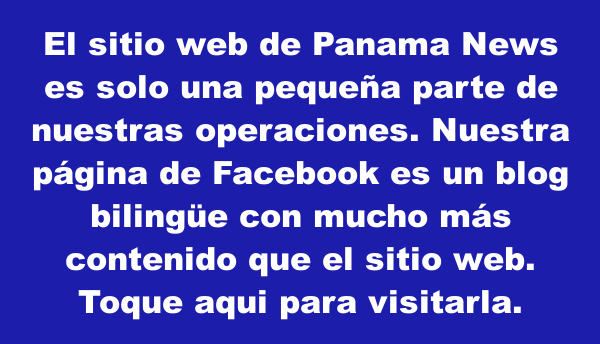

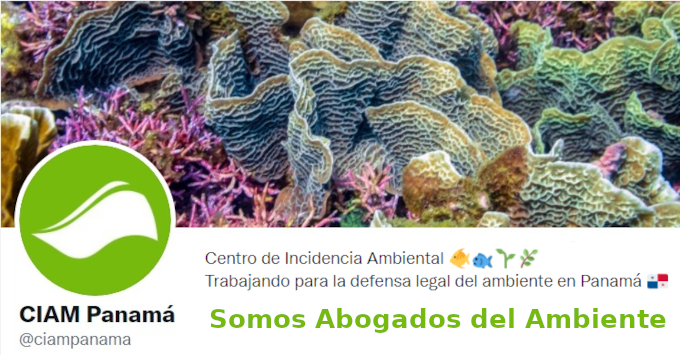


![]()

